#Mesomyzon
Explore tagged Tumblr posts
Text

Fish of the yixian formation

With a scale
#paleoart#lmao#art#paleontology#lots of#Acipenseriformes#sturgeon#and#paddlefish#relatives#yixian formation#fish#formation#Lycoptera#Protopsephurus#sinamia#Peipiaosteus#yanosteus#Mesomyzon#lamprey#small fish#minnow#bait fish#bowfin#that yellow line is intentional#it’s#Hyphalosaurus#reptile#artists on tumblr
118 notes
·
View notes
Text
It’s Jehol Biota Day!
The Jehol Biota is the ecosystem of the Yixian and Jiofotang Formations of northeastern China, dating between 133 and 120 million years ago in the Early Cretaceous (from the Valanginian to Aptian ages).
It is famous because of it’s method of preservation - there were ash eruptions periodically, and the fossils are Lagerstätten, meaning that they were exceptionally well preserved with articulated skeletons, soft tissues, stomach contents, and even coloration.
This has led to an amazing understanding of various types of dinosaurs and other prehistoric animals, especially very birdy dinosaurs.
These animals lived in forests around lakes, dominated by conifers but featuring the earliest flowering plants - Archaefructus, which may have been a water plant.

By Shizhao, CC BY-SA 2.5
There were dry seasons, but it was a mostly wet formation, as many of the plants grew in very wet habitats and probably stayed close to bodies of water.
The Yixian Formation was the older of the two main Jehol Formations, and featured many, many animals. Of invertebrates, there were spiders, crustaceans, dragonflies, flies, wasps, many other insects, and molluscs, of too many to list. Fish included the lamprey Mesomyzon, ray finned fishes such as Lycoptera, Peipiaosteus, Protopsephurus, Sinamia, and Yanosteus, and a potential shark. There were frogs and toads like Callobatrachus, Liaobatrachus, and Mesophryne, as well as a salamander, Liaoxitriton.

Callobatrachus by Emily Willoughby, CC BY-SA 3.0
There were mammals, too, of course - the stem-placental Acristatherium, the stem-marsupials Akidolestes, Maotherium, Zhangheotherium, and Sinodelphys, the stem-therian (Therians being the group of Marsupials and Placentals) Eomaia, the multituberculate (a group of mammals which seem to also be stem-therians) Sinobaatar, and a significant number of Eutriconodonts, a group of early derived mammals, including Chaoyangodens, Gobiconodon, Jeholodens, Juchilestes, Meemannodon, Repenomamus, and Yanoconodon.
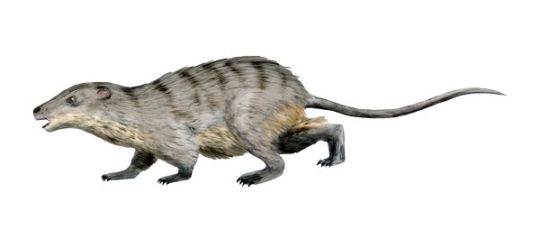
Eomaia by Nobu Tamura, CC BY-SA 3.0
There were the weird early derived Saurians (the group consisting of Lepidosauromorphs and Archosauromorphs, so Extant Reptiles), Choristoderans - Hyphalosaurus, which is known from thousands of specimens, and Monjurosuchus. Lizards included Dalinghosaurus, similar to the modern Chinese Crocodile Lizard; Liushusaurus and Yabeinosaurus, lizards relatedx to modern geckos and skinks, and Xianglong, a gliding lizard. Turtles included Manchurochelys and Ordosemys, both Cryptodirans, a group including giant tortoises, sea turtles, tortoises, snapping turtles, and others.

Hyphalosaurus by Matt Martyniuk, CC BY 3.0

Xianglong by Nobu Tamura, CC BY 3.0
The heroes of the formation were, of course, the Avemetatarsalians. There were many pterosaurs - Beipiaopterus, Boreopterus, Cathayopterus, Elanodactylus, Eosipterus, Feilongus, Gegepterus, Gladocephaloideus, Haopterus, Moganopterus, Ningchengopterus, Pterofiltrus, and Zhenyuanopterus.

Ningchengopterus by Nobu Tamura, CC BY 3.0
Ornithischians included the ornithopods Bolong, Jeholosaurus, and Jinzhousaurus, the ankylosaur Liaoningosaurus, and the ceratopsians Liaoceratops and Psittacosaurus. There were sauropods too - the titanosauriform Dongbeititan, a potential titanosaur, and an animal that has for now been referred to Euhelopus. But the real heavyweights were the theropods.

Jeholosaurus by @ryuukibart
There were the tyrannosauroids Yutyrannus - one of the best known tyrannosauroids with feathers - and Dilong; the compsognathus Huaxiagnathus, Sinocalliopteryx, and Sinosauropteryx - the first non-avian dinosaur known to have feathers, and also with known coloration; early Ornithomimosaurs such as Hexing and Shenzhousaurus; the early derived maniraptoran Yixianosaurus; Beipiaosaurus, a therizinosaur; and tons of Chickenparrots, such as Similicaudipteryx, Protarchaeopteryx, Ningyuansaurus, Incisivosaurus, and Caudipteryx.
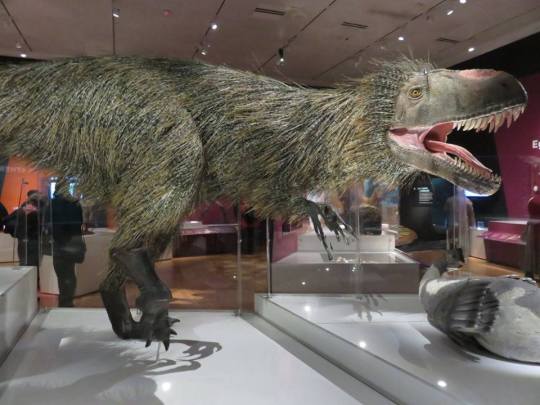
Yutyrannus, model from “Dinosaurs Among Us”, photo by me
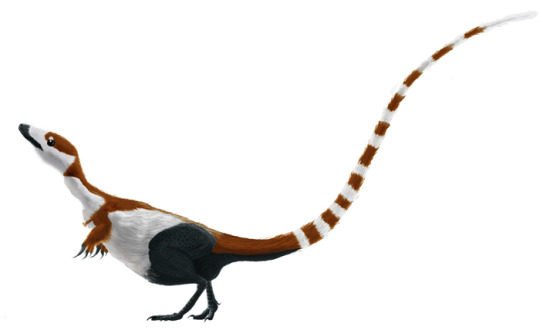
Sinosauropteryx by Matt Martyniuk, CC BY-SA 3.0
There were many Dromaeosaurids (raptors), such as Graciliraptor, Tianyuraptor, Zhenyuanlong - a raptor known from nearly complete feather traces, including extremely large wings - and Sinornithosaurus, the first Dromaeosaurid found with feathers. There were also lots of Troodontids, such as Sinusonasus, Sinovenator, and Mei, as well as unnamed members of both groups. There were early-derived Avialans such as Zhongornis, Jixiangornis, Confuciusornis, and Changchengornis. There were loads of Enantiornithines, such as Bohaiornis, Eoenantironis, Dalingheornis, Liaoningornis, Longirostravis, and Shanweiniao - an Enantiornithine that had a tail fan like modern birds. There were also Euornithines - the group which contains modern birds - such as Longicrusavis, Hongshanornis, and Archaeorhynchus. In short, this was an extremely birdy formation indeed.

Zhenyuanlong by Emily Willoughby, CC BY-SA 4.0
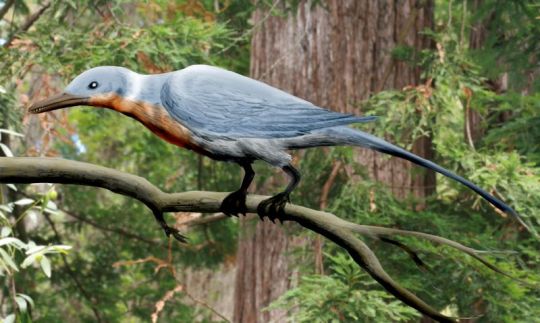
Shanweiniao by Nobu Tamura, CC BY 3.0
The Jiuofotang Formation was slightly younger, but was similar to the Yixian in terms of the animals there. There were ray finned fishes such as Jinanichthys, Lycoptera, Peipiaosteus, Protsephurus, and Sinamia. There was the mammal Liaoconodon, a Eutriconodont, as well as an unnamed mammal similar to Eomaia from the Yixian Formation. There were also Choristoderans like Philydrosaurus, Ikechosaurus, and Liaoxisaurus.

Liaoconodon by Dylan Bajda, CC BY-SA 4.0
There were many, many, many pterosaurs. This included Chaoyangopterus, Eoazhdarcho, Guidraco, Ikrandraco, Jidapterus, Liaoningopterus, Liaoxipterus, Linlongopterus, Nemicolopterus, Nurhachius, Shenzhoupterus, and Sinopterus. And, as we shall see, there were a lot of flying theropods as well, indicating that the two groups did live alongside one another just fine, and the common narrative of “birds replaced pterosaurs” has little foundation in the fossil record.
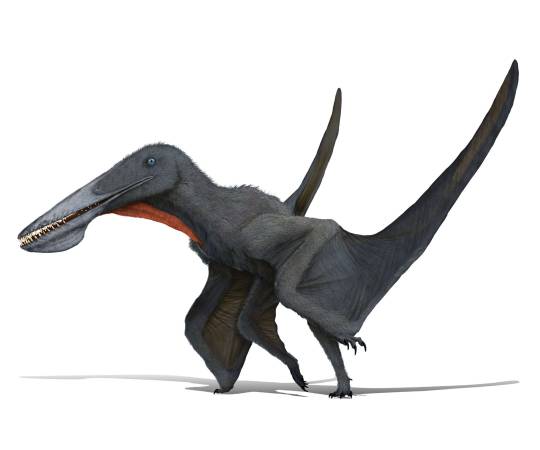
Ikrandraco, by Fabrizio De Rossi, from www.pteros.com

Chaoyangopterus, by Joschua Knüppe, from www.pteros.com
There were only a few Ornithischians - namely Chuanqilong, an ankylosaur, and Psittacosaurus, a ceratopsian. There is also an unnamed titanosaur from the formation. As for theropods, there were a lot. The tyrannosauroid Sinotyrannus was the largest predator there, there was the Chickenparrot Similicaudipteryx, and of course one of the most famous raptors, Microraptor, which was a four-winged Dromaeosaurid that we know had iridescent black feathers.
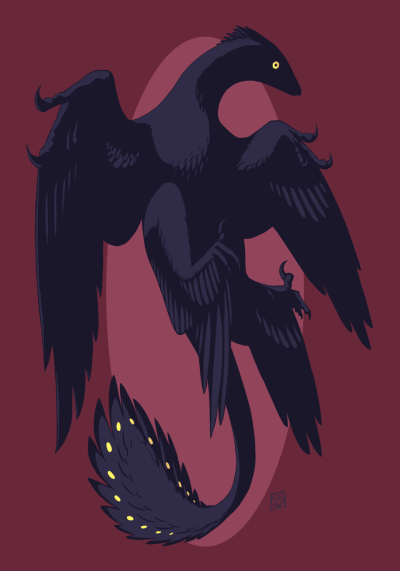
Microraptor by @artisticthingem
There were many early derived Avialans, such as Confuciusornis, Dalianraptor, Omnivoropteryx, Sapeornis, Shenshiornis, Zhongjianornis, and my personal favorite, Jeholornis, a theropod we know was a seed-eater, which is actually quite hard to determine from fossils. There were many Enantiornithines, such as Alethoalaornis, Boluochia, Cathayornis, Cuspirostrisornis, Dapingfangornis, Eocathayornis, Gracilornis, Huoshanornis, Largirostrornis, Longchengornis, Longipteryx, Rapaxavis, Xiangornis, and one of my favorites, Sinornis, which is thought to have perched. As for Euornithines, there was Chaoyangia, Jianchangornis, Parahongshanornis, Schizooura, Songlingornis, Yanornis, and Yixianornis.

Jeholornis by Matt Martyniuk, CC BY-SA 3.0
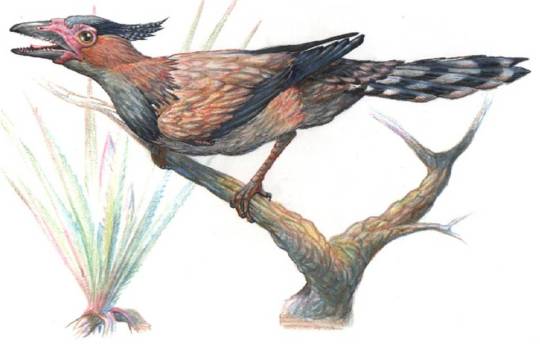
Sinornis, by Pavel Rhia, CC BY-SA 3.0
It’s plain to see why the Jehol Biota is so fascinating. At least for me, I love it because it’s clearly one of the best pictures we have of Pennaraptoran evolution - the amount of birdie dinosaurs is absolutely ridiculous. But there’s really something for everyone here - there are titanosaur-like things, some of the earliest Ceratopsians, tons of Pterosaurs, weird Choristoderans, and even some insights into the evolution of early mammals and different types of amphibians and fish, as well as the first flowering plants. The Jehol Biota is one of the best ecosystems we know about, and it definitely deserves celebration!
Sources:
https://en.wikipedia.org/wiki/Jehol_Biota
https://en.wikipedia.org/wiki/Jiufotang_Formation
https://en.wikipedia.org/wiki/Yixian_Formation
#dinosaurs#birds#pterosaurs#jehol biota#palaeoblr#prehistoric life#yixian formation#jiufotang formation
123 notes
·
View notes